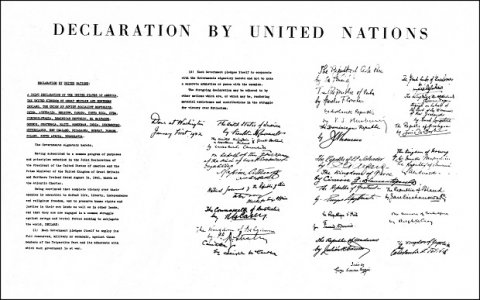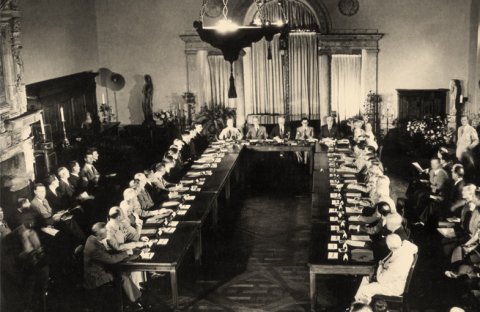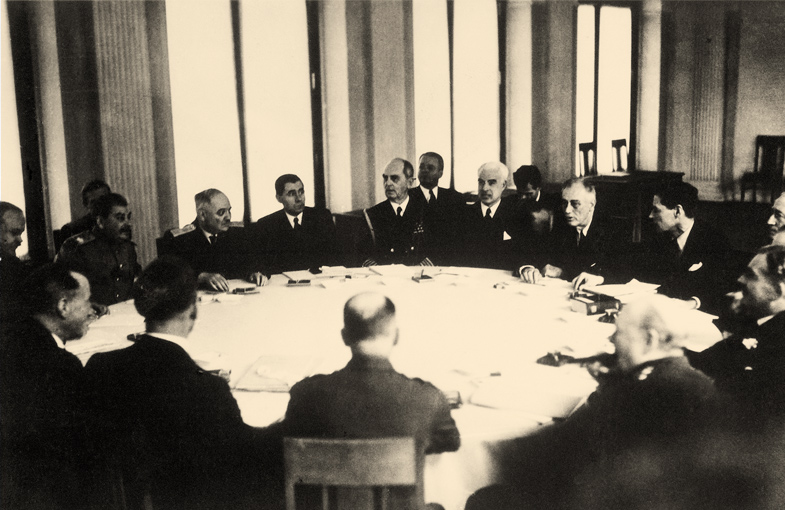One of Douglas Dietrich's longest-held claims has been that the United Nations was created at the Presidio, San Francisco, CA in 1942. The claim may be more accurately described, however, as dis-information intended to reinforce his other false claims about his own involvement with the Presidio and his claim that the United States surrendered to Japan in 1952.
Dietrich's obsession with the Presidio is apparent in his pathetic efforts to establish any credibility for which to base his outrageous claims. Just as pathetic is the failure of his audience to fact-check him when such efforts would take only a matter of minutes.
Dietrich's Claims:
1. The United Nations was created at the Presidio, San Francisco, CA in 1942.
2. The United Nations Conference was held at the Presidio.
3. The United Nations was Headquartered at the Presidio
History of the United Nations
The name "United Nations", coined by United States President Franklin D. Roosevelt was first used in the Declaration by United Nations of 1 January 1942, during the Second World War, when representatives of 26 nations pledged their Governments to continue fighting together against the Axis Powers.
https://www.un.org/en/sections/history-united-nations-charter/1942-declaration-united-nations/index.html
 |
UN Photo/Historical Photo
|
1944-1945: Dumbarton Oaks and Yalta:
The Conference on Security Organization for Peace in the Post-War World constituted the first important step taken to carry out paragraph 4 of the Moscow Declaration of 1943, which recognized the need for a postwar international organization to succeed the League of Nations.
For this purpose, representatives of China, Great Britain, the USSR and the United States met for a business-like conference at Dumbarton Oaks, a private mansion in Georgetown, Washington, D. C. The discussions were completed on October 7, 1944, and a proposal for the structure of the world organization was submitted by the four powers to all the United Nations governments and to the peoples of all countries for their study and discussion.
 |
| UN Photo/Historical Photo: Conference on Security Organization for Peace in the Post-War World |
 | ||
UN Photo/Historical Photo
Leaders of the major allied powers of World War II meeting at Yalta in the Russian Crimea to decide on military plans for the final defeat of Germany.
1945: The San Francisco Conference:
In the spring of 1945, the United Nations had its San Francisco Conference (UN Conference on International Organization) first organizing assembly there. The UN Charter was later drafted and signed in the Herbst Theatre next door. Six years later in 1951, the Treaty of San Francisco, declaring peace with Japan was drafted and signed here and in the Herbst Theatre.
Although the Presidio was one of many sites considered for a potential UN Headquarters, it was never chosen and was never used as a previous temporary site.
|
Every public appearance and presentation by Douglas Dietrich since 2008 has been a feeble, poorly disguised attempt to convince his audience that the Allies lost WW2 and the Axis won. His contempt and disdain for his audiences and angry method of delivery is evident in every presentation.
This slide is shown at the ending of Dietrich's presentations
"The End"
"EMBRACE DEFEAT AND GO IN PEACE"
Dietrich's claims:
1. The surrender of Japan never occurred and the ceremony aboard the USS Missouri was a staged hoax and a satanic ritual "because the Japanese were not carrying swords and the American flag displayed was illegal, with upside-down stars and Satanic."
2. The flag used for the ceremony displayed on the USS Missouri is proof.
3. The Treaty of San Francisco and Security Treaty were signed at the Presidio.
4. The Treaty of San Francisco and Security Treaty were proof of a formal surrender by the Allies to the Japanese and required the Allies to pay reparations to the Japanese.
All Japanese Officer swords had already been surrendered or seized prior to the official ceremony aboard the USS Missouri. It's common knowledge that World War II formally ended with the signing of the Instrument of Surrender aboard the USS Missouri in Tokyo Bay on Sept. 2, 1945.
The flag which was displayed on the starboard veranda deck of the USS Missouri was the same flag flown by Commodore Mathew Perry's ship in 1853-54 during the forced opening of Japanese ports to foreign trade.
The flag was displayed backward, and the stars not "upside-down" as Dietrich claims, but with it's "reverse side" showing. All US flags which are on the right of an object, aircraft, ship or person are displayed with the star field to the upper right corner so the flag appears to be heading forward.
John Bremyer oral history interview:
http://digitalarchive.pacificwarmuseum.org/cdm/ref/collection/p16769coll1/id/5563
(Scene from the Japanese Surrender Ceremony aboard the USS Missouri (BB-63). "The flag Admiral Perry carried to Japan many years ago." Tokyo Bay, Japan. 2 September 1945)
https://www.ww2online.org/image/commodore-matthew-perrys-american-flag-aboard-uss-missouri-bb-63-tokyo-bay-japan-2-september
https://www.pinterest.com/pin/485333297313857462/
The flag is neither illegal or improper. According to USC Title 4: "Definition of flag- stars," There is no legal stipulation regarding the type of orientation of stars on the US flag. A later Presidential Executive Order that details the specifications for US flags used by the Federal Government states the points should "face upward". It is, however, not law.
In fact a similar star pattern is also seen on the original "Star-Spangled Banner"
The stars are oriented in a "back and forth" pattern row to row. The points on top are slightly canted to "the fly," the second row toward "the hoist, and so on. A pattern in those days referred to as "dancing stars."
The surrender ceremony was indeed a carefully composed event, "involving 258 warships. A massive fly-over had been choreographed to conclude the ceremony, but leaden skies seemed to prohibit it. However, the instant the ceremony ended, the clouds parted as if on divine cue. Under fresh sunlight, 462 B-29s and 450 carrier planes sounded a deafening final benediction.
Mounted on a bulkhead overlooking the veranda deck was a glass case. It contained the American flag Commodore Matthew Perry flew in 1853 when he sailed into Tokyo Bay to initiate formal American relations with Japan—a symbol Admiral Halsey ordered transported by courier from the U.S. Naval Academy Museum. Perry’s ship had been anchored near that spot 92 years earlier; Captain Murray hung the flag where the arriving Japanese delegation was sure to see it."
https://www.historynet.com/altar-of-peace-symbolism-at-japanese-surreder-ceremony.htm
https://ibiblio.org/hyperwar/OnlineLibrary/photos/events/wwii-pac/japansur/js-8i.htm
The Treaty of San Francisco and Security Treaty with Japan:
This slide is shown at the ending of Dietrich's presentations
"The End"
"EMBRACE DEFEAT AND GO IN PEACE"
Dietrich's claims:
1. The surrender of Japan never occurred and the ceremony aboard the USS Missouri was a staged hoax and a satanic ritual "because the Japanese were not carrying swords and the American flag displayed was illegal, with upside-down stars and Satanic."
2. The flag used for the ceremony displayed on the USS Missouri is proof.
3. The Treaty of San Francisco and Security Treaty were signed at the Presidio.
4. The Treaty of San Francisco and Security Treaty were proof of a formal surrender by the Allies to the Japanese and required the Allies to pay reparations to the Japanese.
All Japanese Officer swords had already been surrendered or seized prior to the official ceremony aboard the USS Missouri. It's common knowledge that World War II formally ended with the signing of the Instrument of Surrender aboard the USS Missouri in Tokyo Bay on Sept. 2, 1945.
The flag which was displayed on the starboard veranda deck of the USS Missouri was the same flag flown by Commodore Mathew Perry's ship in 1853-54 during the forced opening of Japanese ports to foreign trade.
The flag was displayed backward, and the stars not "upside-down" as Dietrich claims, but with it's "reverse side" showing. All US flags which are on the right of an object, aircraft, ship or person are displayed with the star field to the upper right corner so the flag appears to be heading forward.
"Two American flags were hoisted on the deck for the surrender ceremony in 1945. One had flown on the mast of Commodore Matthew Perry's ship when he sailed into Tokyo Bay in 1853 to encourage Japan to open its ports to foreign trade.
Nearly a century later, that flag was so fragile that the conservator at the Naval Academy Museum directed that a protective backing be sewn on it, leaving its "wrong side" visible. The flag was flown that way for the surrender ceremony, and that's why its replica appears that way on the Missouri today."
Commodore Perry's Flag 1853 and 1946
In July of 1853, Commodore Matthew Perry entered Tokyo Bay with a squadron of then-modern warships flying this 31-star flag to secure a treaty with Japan. His success led to formal diplomatic ties, access of ports by American ships, aid for shipwrecked American sailors, commercial trade, and the opening of Japan to other Western nations.
Ninety-two years later, at the request of Perry's cousin, General Douglas MacArthur, the flag was transported from Annapolis, Maryland, to be on hand for the surrender ceremony of the Japanese ending World War II. The 9,500-mile trip took 120 hours and covered 12 time zones. The courier, who orders required him to keep the wooden box containing the flag in his sight at all times, slept with it, ate with it, and even took it with him in the bathroom. The flag had been on display at the museum at Annapolis where conservators had mounted cotton to its mildew damaged front side to prevent the flag from breaking apart and then mounted it backward to hide the damage. The flag case was mounted on the bulkhead of the Battleship Missouri overlooking the ceremony. After its 120 hour trip, the courier slept for two days missing the 25 minute ceremony.
Identity of WW2 courier and Perry Flag
This report refutes the claim that the courier slept for 2 days and missed the ceremony.
Flyboys World War II Perry Flag Flight By Scott Spangler on July 1st, 2019
"Until just before the surrender, the Perry flag was on display at a museum at the U.S. Naval Academy in Annapolis, Maryland. Someone thought its display at the surrender was significant enough to entrust it to a courier, Lt. John Bremyer. Starting from Annapolis, he took off from Iwo Jima on August 29, 1945, “the last leg of a record-breaking120-hour, 9,500-mile-long trip that had taken him through 12 time zones.”
It turns out that there was no dedicated flight, which was slightly disappointing. On the other hand, I learned about a Priority One (or One Priority) World War II military travel voucher, which guaranteed a seat on the next airplane, regardless of type or what passenger got bumped, going in the right direction. When he reported to work that morning, he didn’t expect the assignment.
Bremyer was in the air that evening, headed to San Francisco. From there he took the next plane to Hawaii, then Johnston Island, Kwajalein, Guam, and then Iwo Jima. There “they were going to to put me on a destroyer, but that would take too long, so I got on a Black Cat PBY” that took him to Tokyo Bay, where a whaleboat from the Missouri collected him and Perry’s flag.
Watching the proceedings from the above the main deck, Bremyer carried the flag, as well as news releases, photographs, and motion picture film of the surrender back to Washington. “I got on a PBM [Martin Mariner seaplane] back to Guam and basically followed the same route back to San Francisco,” the 85-year-old veteran remembered.
He carried Commodore Perry’s flag to the Japanese surrender in Tokyo Bay. John received national recognition for his role in that historic event, made many presentations around the country and recently wrote a book on the Perry Flag that includes his own “Kansas Pioneer Family History
https://www.gliddenedigerfuneral.com/obituaries/John-Bremyer/#!/ObituaryJohn Bremyer oral history interview:
http://digitalarchive.pacificwarmuseum.org/cdm/ref/collection/p16769coll1/id/5563
Perry’s flag is back on display at the Naval Academy Museum, and it is No. 89 in “A History of the Navy in 100 Objects.” It gives more background on the decision-making process that sent the flag to Japan, and it mentions Lt. Bremyer’s “record-setting” trip. But like Bradley in Flyboys, it doesn’t explain what record Bremyer’s trip set or surpassed. –Scott Spangler, Editor.
Notice the irregular star field, a common feature in 19th century flags when there were no design standards. In this case, they apparently just stuffed the extra star into the first column to get 31 stars and the stars are all tilted to the left.
(Scene from the Japanese Surrender Ceremony aboard the USS Missouri (BB-63). "The flag Admiral Perry carried to Japan many years ago." Tokyo Bay, Japan. 2 September 1945)
https://www.ww2online.org/image/commodore-matthew-perrys-american-flag-aboard-uss-missouri-bb-63-tokyo-bay-japan-2-september
https://www.pinterest.com/pin/485333297313857462/
In fact a similar star pattern is also seen on the original "Star-Spangled Banner"
The stars are oriented in a "back and forth" pattern row to row. The points on top are slightly canted to "the fly," the second row toward "the hoist, and so on. A pattern in those days referred to as "dancing stars."
The surrender ceremony was indeed a carefully composed event, "involving 258 warships. A massive fly-over had been choreographed to conclude the ceremony, but leaden skies seemed to prohibit it. However, the instant the ceremony ended, the clouds parted as if on divine cue. Under fresh sunlight, 462 B-29s and 450 carrier planes sounded a deafening final benediction.
Mounted on a bulkhead overlooking the veranda deck was a glass case. It contained the American flag Commodore Matthew Perry flew in 1853 when he sailed into Tokyo Bay to initiate formal American relations with Japan—a symbol Admiral Halsey ordered transported by courier from the U.S. Naval Academy Museum. Perry’s ship had been anchored near that spot 92 years earlier; Captain Murray hung the flag where the arriving Japanese delegation was sure to see it."
https://www.historynet.com/altar-of-peace-symbolism-at-japanese-surreder-ceremony.htm
https://ibiblio.org/hyperwar/OnlineLibrary/photos/events/wwii-pac/japansur/js-8i.htm
The Treaty of San Francisco and Security Treaty with Japan:
The Treaty of San Francisco, also called the Treaty of Peace with Japan, re-established peaceful relations between Japan and the Allied Powers after World War II. It was officially signed by 49 nations on September 8, 1951, in San Francisco, California at the War Memorial Opera House.[1] It came into force on April 28, 1952, and officially ended the American-led Allied occupation of Japan. According to Article 11 of the treaty, Japan accepts the judgments of the International Military Tribunal for the Far East and of other Allied War Crimes Courts imposed on Japan both within and outside Japan.[2]
This treaty served to officially end Japan's position as an imperial power, to allocate compensation to Allied civilians and former prisoners of war who had suffered Japanese war crimes during World War II, and to end the Allied post-war occupation of Japan and return full sovereignty to that nation. This treaty made extensive use of the United Nations Charter[3] and the Universal Declaration of Human Rights[4] to enunciate the Allies' goals.
This treaty, along with the Security Treaty signed that same day, is said to mark the beginning of the San Francisco System; this term, coined by historian John W. Dower, signifies the effects of Japan's relationship with the United States and its role in the international arena as determined by these two treaties and is used to discuss the ways in which these effects have governed Japan's post-war history.
This treaty also introduced the problem of the legal status of Taiwan due to its lack of specificity as to what country Taiwan was to be surrendered, and hence some supporters of Taiwan independence argue that the sovereignty of Taiwan is still undetermined.
Conclusion:
The formal surrender of Japanese was no hoax and the Perry flag displayed in the ceremony was neither satanic nor illegal and certainly had nothing to do with any "satanic" symbolism or ritual. Douglas Dietrichs' claim that the United States surrendered to Japan on September 8, 1951, is unsubstantiated bullshit. And so is his claim that it occurred "on-site the Presidio."
Dietrich's' references in his shows to the courier who transported the Perry flag from Annapolis, MD to Tokyo Japan for the surrender ceremony, is proof that Dietrich knows what the true history is, but has intentionally twisted it for his own purposes of disinformation and deceit.
Dietrich's' references in his shows to the courier who transported the Perry flag from Annapolis, MD to Tokyo Japan for the surrender ceremony, is proof that Dietrich knows what the true history is, but has intentionally twisted it for his own purposes of disinformation and deceit.

















